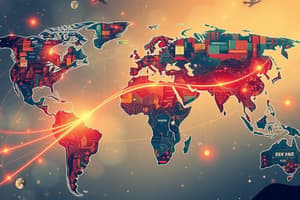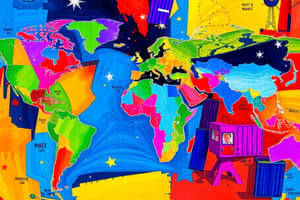Podcast
Questions and Answers
Which of the following best describes globalization?
Which of the following best describes globalization?
- The decline of international trade.
- The increasing interconnectedness of businesses, cultures, and economies worldwide. (correct)
- The process of isolating national economies.
- A focus on local production and consumption.
Standardization of products across different markets is a globalization strategy aimed at appealing to diverse local tastes.
Standardization of products across different markets is a globalization strategy aimed at appealing to diverse local tastes.
False (B)
Name three drivers of globalization mentioned.
Name three drivers of globalization mentioned.
Technological advancements, trade liberalization, growth of multinational corporations.
A major disadvantage of globalization includes increased ______ between developed and developing nations.
A major disadvantage of globalization includes increased ______ between developed and developing nations.
Match the following types of globalization with their correct descriptions:
Match the following types of globalization with their correct descriptions:
Which international organization primarily ensures fair global trade practices?
Which international organization primarily ensures fair global trade practices?
Protectionism involves countries reducing trade barriers to promote globalization.
Protectionism involves countries reducing trade barriers to promote globalization.
What is Corporate Social Responsibility (CSR) in the context of global business?
What is Corporate Social Responsibility (CSR) in the context of global business?
The rise of e-commerce platforms such as ______ and Shopify allows businesses to sell globally.
The rise of e-commerce platforms such as ______ and Shopify allows businesses to sell globally.
Match the following examples with their correct type of globalization:
Match the following examples with their correct type of globalization:
What is a key focus of sustainable supply chains in global business?
What is a key focus of sustainable supply chains in global business?
Outsourcing operations usually lead to increased wages in developed nations.
Outsourcing operations usually lead to increased wages in developed nations.
Name an advantage and a disadvantage of globalization.
Name an advantage and a disadvantage of globalization.
The Paris Agreement aims to reduce global ______ emissions.
The Paris Agreement aims to reduce global ______ emissions.
Match the country with the adaptation McDonald's made to their menu there:
Match the country with the adaptation McDonald's made to their menu there:
Which technological advancement has significantly enhanced real-time business operations across borders?
Which technological advancement has significantly enhanced real-time business operations across borders?
The Rana Plaza disaster in Bangladesh highlighted the positive impacts of outsourcing manufacturing to low-wage countries.
The Rana Plaza disaster in Bangladesh highlighted the positive impacts of outsourcing manufacturing to low-wage countries.
What are two skills essential for navigating the global business environment?
What are two skills essential for navigating the global business environment?
Tesla's expansion into international markets is primarily driven by the global demand for ______ vehicles.
Tesla's expansion into international markets is primarily driven by the global demand for ______ vehicles.
Match the following organizations with their roles:
Match the following organizations with their roles:
Flashcards
What is Globalisation?
What is Globalisation?
The increasing interconnectedness of businesses, cultures, and economies worldwide.
Globalisation of Markets
Globalisation of Markets
Expanding business operations internationally to increase market share.
Globalisation of Production
Globalisation of Production
Sourcing production processes from different countries to reduce costs.
Economic Globalisation
Economic Globalisation
Signup and view all the flashcards
Political Globalisation
Political Globalisation
Signup and view all the flashcards
Cultural Globalisation
Cultural Globalisation
Signup and view all the flashcards
Technological Globalisation
Technological Globalisation
Signup and view all the flashcards
Environmental Globalisation
Environmental Globalisation
Signup and view all the flashcards
Trade Liberalisation
Trade Liberalisation
Signup and view all the flashcards
Multinational Corporations (MNCs)
Multinational Corporations (MNCs)
Signup and view all the flashcards
Corporate Social Responsibility (CSR)
Corporate Social Responsibility (CSR)
Signup and view all the flashcards
Government's Role in Globalisation
Government's Role in Globalisation
Signup and view all the flashcards
United Nations (UN)
United Nations (UN)
Signup and view all the flashcards
World Trade Organization (WTO)
World Trade Organization (WTO)
Signup and view all the flashcards
Protectionism
Protectionism
Signup and view all the flashcards
E-commerce in Globalisation
E-commerce in Globalisation
Signup and view all the flashcards
Cross-Cultural Communication
Cross-Cultural Communication
Signup and view all the flashcards
Adaptability
Adaptability
Signup and view all the flashcards
Sustainable Business Models
Sustainable Business Models
Signup and view all the flashcards
Sustainable Supply Chains
Sustainable Supply Chains
Signup and view all the flashcards
Study Notes
Introduction to Globalisation
- Globalisation describes the increasing interconnectedness of businesses, cultures, and economies worldwide.
- Globalisation drives economic growth, increases competition and enhances cultural exchange.
- Key trends include digital trade growth, international outsourcing, and market integration.
- E-commerce platforms like Amazon provide worldwide access to previously unavailable products.
Globalisation of Markets
- Businesses expand internationally to increase market share.
- Standardisation of products helps meet global consumer demands.
- Companies adapt products for local tastes while maintaining brand identity.
- McDonald’s offers unique menu items based on regional preferences.
Globalisation of Production
- Companies outsource production to different countries for cost efficiency.
- Supply chains are essential for logistics and sourcing materials globally.
- Apple assembles iPhones in China, sources components from South Korea, and designs them in the USA.
Types of Globalisation
- Economic globalisation involves integration through trade and investment.
- Political globalisation involves the influence of international policies and organisations.
- Cultural globalisation involves the spread of ideas, languages, and lifestyles.
- Technological globalisation involves rapid digitalisation and internet penetration.
- Environmental globalisation involves global cooperation on climate change.
Drivers of Globalisation
- Technological advancements like the Internet, AI, and automation drive globalisation.
- Trade liberalisation through reduced tariffs and trade barriers promotes globalisation.
- Growth of multinational corporations (MNCs) drives globalisation.
- Improved transportation and communication enhance globalisation.
- 5G networks enhance real-time business operations across borders.
Capitalism and Globalisation
- Capitalism fuels global expansion through free markets.
- Competition drives innovation and efficiency.
- Tesla is expanding into international markets due to demand for electric vehicles.
Advantages of Globalisation
- Economic growth and foreign investments are advantages of globalisation.
- Innovation through knowledge exchange is an advantage of globalisation.
- Increased market competition leads to better products and lower prices.
- China’s economic growth surged due to global trade and foreign investments.
Disadvantages of Globalisation
- Income inequality, with a wealth gap between developed and developing nations, is a disadvantage.
- Exploitation of labour, with poor working conditions in low-wage countries, is a disadvantage.
- Environmental concerns like overconsumption and pollution are disadvantages of globalization.
- The 2013 Rana Plaza disaster highlighted the dangers of outsourcing manufacturing to low-wage countries.
Key Players in Global Business
- Multinational Corporations (MNCs) operate in multiple countries.
- Entrepreneurs and small businesses benefit from global e-commerce platforms.
- Amazon, Tesla, and small businesses use Etsy to reach international customers.
Globalisation’s Impact on Jobs
- Job creation occurs in developing nations, but job losses occur in developed ones.
- Outsourcing operations happens in countries with lower wages.
- Wage disparity exists between developed and developing nations.
- Many customer service jobs are outsourced to countries like India and the Philippines due to lower wages.
Global Business Thinking
- Corporate Social Responsibility (CSR) involves ethical business practices.
- Sustainable business models include fair trade and eco-friendly initiatives.
- Sustainable supply chains focus on reducing environmental impact.
- Patagonia focuses on sustainable manufacturing to minimize environmental harm.
Role of Governments & International Organisations
- Governments regulate trade policies, balancing domestic and global interests.
- The United Nations (UN) promotes peace and economic development.
- The World Bank & IMF provide financial support to countries.
- The WTO ensures fair global trade practices.
- The World Trade Organization (WTO) resolves trade disputes between countries.
Challenges of Globalisation
- Protectionism involves countries imposing trade barriers.
- Political instability can involve trade wars and conflicts.
- Ethical concerns include child labour and environmental damage.
- The U.S.-China trade war led to increased tariffs and affected global supply chains.
Digital Globalisation and Technology
- Growth of e-commerce and digital businesses.
- Artificial intelligence and big data transforming global markets.
- Cybersecurity risks and protection strategies.
- Companies like Alibaba and Shopify enable businesses to sell globally through digital platforms.
The Future of Globalisation
- Emerging markets are present in Africa, South America, and Southeast Asia.
- Deglobalisation trends include rising nationalism and protectionism.
- There is a sustainability focus on a green economy and eco-friendly global policies.
- Many companies now prioritize sustainable sourcing to reduce their environmental impact.
Developing Skills for the Global Business Environment
- Cross-cultural communication involves understanding business etiquette in different regions.
- Digital literacy involves adapting to global digital trends.
- Adaptability involves building competencies for global career success.
- Learning multiple languages can enhance job opportunities in international business.
Studying That Suits You
Use AI to generate personalized quizzes and flashcards to suit your learning preferences.




